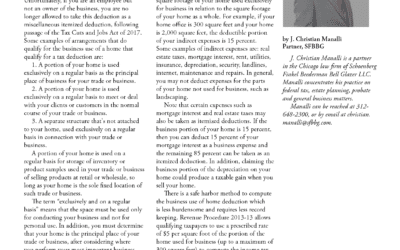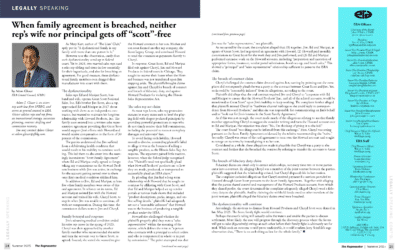Question: Can I still make qualified charitable distributions from my IRA after the recent legislative changes?
Answer: Qualified charitable distributions (“QCDs”) are still a viable planning opportunity despite recent legislative changes impacting Individual Retirement Accounts (“IRAs”). Taxpayers who have attained age 70 ½ are still permitted to make QCDs, direct transfers of up to $100,000 per year from their IRAs to qualifying charitable organizations. While IRA distributions are generally subject to income tax, the amount withdrawn from an IRA as a QCD is not taxable. Absent QCD treatment, an IRA distribution would be subject to income tax while the charitable contribution would primarily only be deductible as an itemized deduction. The legislative change increasing the minimum age at which taxpayers must commence distributions from their retirement accounts and other statutory changes have not impacted the benefits of QCDs.
Taxpayers with IRAs are required to commence distributions, so-called minimum required distributions or RMDs, at a specified age. Prior to the passage of the Setting Every Community Up for Retirement Act in 2019 (the “Secure Act”), the age for commencing RMDs was age 70 ½, the same age at which taxpayers were allowed to make QCDs. The Secure Act increased the age at which taxpayers are required to commence RMDs to age 72. This legislative change notwithstanding, QCDs can still be made by taxpayers who have attained age 70 1/2.
The Secure Act also eliminated the age restriction on making IRA contributions. Previously, taxpayers were not eligible to make IRA contributions after attaining age 70 1/2, even if they had earned income from employment or some other source and otherwise qualified to make such contributions. There is no longer a limit on the age at which IRA contributions can be made for taxpayers with earned income.
There is, however, a new twist on the favorable tax treatment of QCDs for taxpayers who make deductible IRA contributions after attaining age 70 ½. The amount of a QCD which qualifies for exclusion from income must be reduced by the amount of the deductible IRA contributions made after attaining such age. So if a taxpayer who has attained age 70 ½ makes a $12,000 QCD and a $5,000 deductible IRA contribution, only $7,000 qualifies for favorable QCD treatment and the $5,000 balance of the charitable distribution from the IRA must be includable in the taxpayer’s income. The congressional intent is designed to prevent taxpayers from reaping a windfall by deducting an IRA contribution and then making a QCD which is not subject to income tax.
Despite the legislative changes, considerable benefits from QCDs remain. QCDs provide meaningful benefits for taxpayers who reside in States that do not allow itemized deductions. A taxpayer who resides in a State not allowing itemized deductions and who withdraws money from an IRA and makes a corresponding charitable contribution will be subject to State income taxes on the full amount of the withdrawal without an offsetting state income tax deduction. With a QCD, the taxpayer need not report the income and therefore is in the same position as a taxpayer who resides in a state which permits itemized deductions and can deduct the charitable contribution. Other tax benefits from QCDs are realized where certain amounts are taxed based on a taxpayer’s adjusted gross income (“AGI”). Social security benefits, for example, are taxable if a taxpayer’s AGI reaches certain thresholds. With a QCD which is not includable in income, a taxpayer’s AGI is not increased and the taxation of social security benefits is not impacted as would be the case if the taxpayer withdrew funds from an IRA and made a charitable contribution.
Any taxpayer maintaining an IRA who makes charitable contributions after attaining age 70 ½ would be well advised to make the charitable gift as a QCD. Although the Secure Act made the tax rules more complicated, considerable benefits remain for charitably inclined septuagenarians and older taxpayers with IRAs.
The Tax Corner addresses various tax, estate, asset protection and other business matters. Should you have any questions regarding the subject matter or if you have questions you want answered, you may contact Bruce at (312) 648-2300 or send an e-mail to [email protected].



